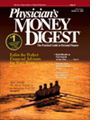Publication
Article
Physician's Money Digest
Strengthen Your Retirement with Charity
Author(s):
When working with physiciansspecializing in retirement andestate planning needs, an areatheir advisors often overlook is charitablegiving. Many physicians desire to giveback to society, as well as help those inimmediate need. They also have an interestin establishing a lasting social legacywhile teaching their children the principleof giving. Unfortunately, many benefits(eg, increased lifetime income for retirementand income and estate tax reduction)are lost due to a lack of knowledgeableplanned charitable giving.
Charitable Giving
The charitable sector now represents6% of our nation's economy. The SocialWelfare Research Institute at BostonCollege estimates that 97% of US householdswith a net worth in excess of $1million and 99% of households with anet worth in excess of $5 million give tocharitable organizations annually. At thepresent rate of giving, charities willreceive as much as $53 trillion in donationsby the year 2055.
One of the simplest, least expensive,and possibly most beneficial method forplanned charitable giving is the charitablegift annuity (CGA). Each year, thousandsof Americans make generous charitablegifts by creating CGAs. In doingso, they are able to support churches,schools, and other qualified charitableorganizations of their choice whileenjoying the financial advantages of aCGA in their planned giving.
Case Study
Robert Smith, MD, and his wife arecontemplating retirement in 10 years. Atage 55 and in good health, they areenjoying a comfortable annual incomeand a diverse estate. Although in desperateneed of tax relief and maxing theirqualified retirement plan contributions,the Smiths are secure in their retirementplans. Now their interest is directedtoward leaving as much as they can totheir children along with their favoritecharities and almae matres.
By simplified planned giving using aCGA, they can realize an immediateincome tax deduction to be used againstcurrent tax liabilities, retirement incomeguaranteed for life (based on the claim-payingability of the charity), and a lastingsocial legacy. By implementing a CGAwith an annual contribution for 10 years,Dr. and Mrs. Smith will enjoy the followingbenefits:
• An immediate income tax deductioncan and should be used each year ofcontribution when Dr. Smith's tax ratesare at their highest.
• A total income tax deduction overthe 10 years can be used for a number ofplanning options, including replacingthe value of the contributions to theirfamily, thus achieving a partial wealthreplacement through the donation.
• In 10 years, Dr. Smith will begin toreceive annual income, which is guaranteedfor joint life. A portion of theincome is income tax-free and non-reportablethrough normal mortality.
• At the death of Dr. Smith and hiswife, a donor-advised fund in the familyname will be established to carry on thework of the charity.
As a result of simplified planned giving,Dr. Smith is able to increase hisretirement income, minimize his taxes,secure value to his heirs, and create alegacy for his family.
Richard G. English, ChFC, CLU,
is an investment advisor representative
of InterSecurities, Inc.
Mr. English specializes in estate
planning and charitable giving.
He welcomes questions or comments
from readers at 817-572-6395 or rgefinan
cial@sbcglobal.net. You may ask for a free personal
and confidential charitable giving analysis
prepared exclusively for you. Securities
offered through InterSecurities, Inc, member
NASD, SIPC, a registered investment advisor
located in Gold River, Calif.
